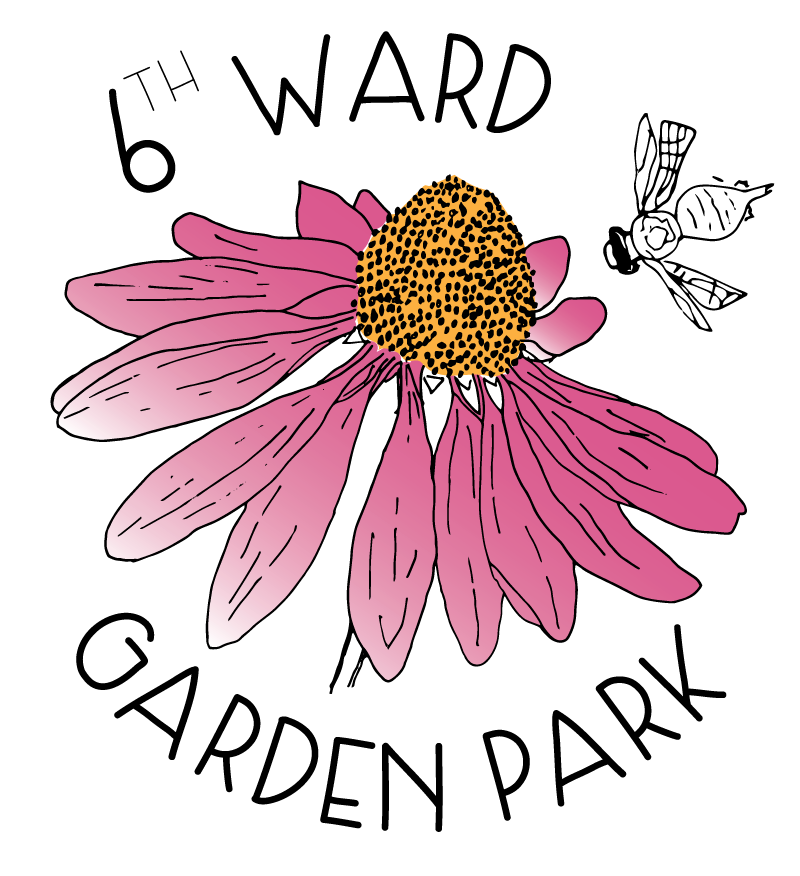Building Soil by Sheet-Mulching
Sheet-mulching the garden, Fall 2015
Building Soil by Sheet-mulching
At the 6th Ward Garden Park, we started with nutrient-poor soil that was extremely compacted on the east side of the Park. To create the Garden Park, we needed to literally build from the ground up. Since healthy plants need healthy soil, that’s where we began.
One way to build soil is to “sheet mulch”. Sheet mulching is a bit like making lasagna – think layers.
We want to reduce (ideally prevent) weed growth while building healthy soil. Sheet mulch can be simple, using newspaper and 8-12 inches of mulch. If you want to create a “bomber” sheet mulch, add more ingredients and layers.
This recipe for sheet mulch comes from Toby Hemenway’s Gaia’s Garden. At the Garden Park, we have covered approximately 14,000 square feetwith sheet mulch! At home, most of us will work with a much smaller area. The volumes below are approximate and should cover a 50 square foot area – if you are working in a larger area, multiply!
Ingredients/Materials
Newspaper or Cardboard: 1-2 foot stack of newspaper (pull out the glossy inserts) or better yet, enough corrugated cardboard (remove tape, labels, and staples) to cover 50 square feet with one layer. It is best to use cardboard, and then cover the seams with newspaper.
Additional Nutrients: Test your soil and include any needed nutrients (“soil amendments”) as indicated by the results. For instance, if your soil is acidic, you may want to add lime; if it’s alkaline, you can add gypsum or sulfur. If you’re short on phosphorus, you can add rock phosphate or bonemeal. If your soil lacks trace minerals, add greensand, kelp meal, or rock dust. Test your soil with a kit from a home improvement store or better yet, by working with the local extension office.
Bulk Organic Material: In this sense, organic does not necessarily mean without chemicals but rather containing organic (carbon-rich) material. If you can, it is best to use chemical-free material such as spoiled hay, yard waste, leaves, or in the case of the Garden Park, we were the lucky recipient of tons of horse manure mixed with straw (Thank you, Derek Brown and Tia Nelson!). You will need about 1-2 cubic yards of loose bulk mulch material or 2-4 bales of hay or straw.
Compost: 1 ½ to 3 cubic feet of compost
Top Layer: ½ cubic yard or 1-2 rectangular hay or straw bales
You do not need to collect exactly these items in exactly these quantities; sheet mulching is pretty flexible. We are working with nature to build the soil, providing food and water for the microbes and other decomposers, including earthworms.
To improve your soil, you just need to have the basics - a barrier layer (newspaper/cardboard) and organic material.
Installing Sheet Mulch
Prepare the soil
Collect and assemble your *materials near the area where you plan to install the sheet mulch. (See ingredients below.)
The day before you begin, water the area. Unless it just rained, you will need to water the ground.
Add any soil amendments (if any were suggested by the soil test results).
If your soil is compacted or heavy with clay, loosen the soil with a shovel or spade. (No need to turn the soil.)
Installation
Remember, think lasagna!
- Add a thin layer of manure (this is the nitrogen source)
- Spread the cardboard/newspapers – this is the “sheet” or barrier. It's best to overlap and be sure to cover the cardboard seams with newspaper. If only using newspaper, ensure that the layers are up 1/8-1/2 inch thick
- Water the sheets thoroughly as you go. It’s important to get enough water to help the decomposers work their magic!
- More manure (you can also you fresh grass clippings), this is food for the "decomposers"
- Add 8-12” of bulk material, watering every few inches to keep it damp (not wet)
- Add 1-2 inches of compost
If you plan to plant this area soon, you can stop here.
If you don't plant in the next few weeks, prepare the bed for later: Add the final touches with 2 inches of cover material (wood shavings, chips, straw. This layer should be weed and seed-free).
Congratulations, your sheet mulch installation is done!
Remember to water regularly to help speed up the decomposition and soil-building process.
At the 6th Ward Garden Park, we installed the sheet mulch in the fall and by spring planting, the cardboard had all but vanished (it actually “disappeared” and reappeared in combination with other layers as new soil). Those microbes and earthworms were happily digesting our “lasagna” and making great soil, as good decomposers do.
Sheet Mulching from Fix.com
